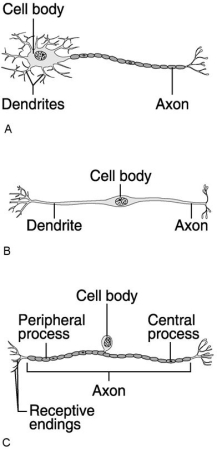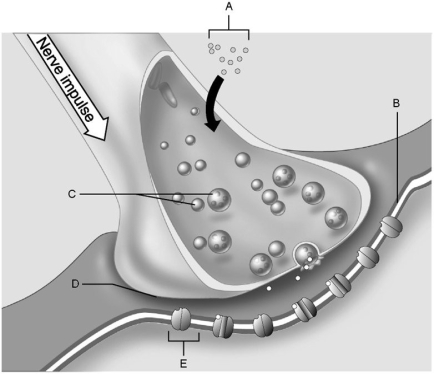A) C
B) B
C) A
E) A) and C)
Correct Answer

verified
Correct Answer
verified
True/False
In myelinated axons the voltage-regulated sodium channels are concentrated at the nodes of Ranvier.
B) False
Correct Answer

verified
Correct Answer
verified
Multiple Choice
When a sensory neuron is excited by some form of energy,the resulting graded potential is called a(n) ________.
A) action potential
B) excitatory potential
C) postsynaptic potential
D) generator potential
F) All of the above
Correct Answer

verified
Correct Answer
verified
Multiple Choice
Which of the following is true about the movement of ions across excitable living membranes?
A) Ions always move actively across membranes through leakage channels.
B) Sodium gates in the membrane can open in response to electrical potential changes.
C) Ions always move from an area of higher concentration to an area of lower concentration.
D) Ions always move passively across membranes.
F) B) and C)
Correct Answer

verified
Correct Answer
verified
Multiple Choice
The concentration of ions in the chemical environment surrounding the neurons must be tightly regulated for neurons to function properly.Which of the following cells is most responsible for this?
A) satellite cells
B) astrocytes
C) Schwann cells
D) oligodendrocytes
F) All of the above
Correct Answer

verified
Correct Answer
verified
Short Answer
When information is delivered within the CNS simultaneously by different parts of the neural pathway,the process is called ________ processing.
Correct Answer

verified
Correct Answer
verified
True/False
A postsynaptic potential is a graded potential that is the result of a neurotransmitter released into the synapse between two neurons.
B) False
Correct Answer

verified
Correct Answer
verified
Multiple Choice
Bacteria in the blood can be prevented entry to the fluids surrounding the brain.Which cells are most responsible for preventing bacteria from entering the fluids of the brain?
A) satellite cells
B) astrocytes
C) Schwann cells
D) oligodendrocytes
F) All of the above
Correct Answer

verified
Correct Answer
verified
Multiple Choice
Which of the following correctly describes a graded potential?
A) it has a depolarization, repolarization and hyperpolarization phase
B) it can have amplitudes of various sizes
C) it is initiated by voltage changes in the membrane
D) it travels long distances
F) A) and C)
Correct Answer

verified
Correct Answer
verified
Multiple Choice
 Figure 11.1
Using Figure 11.1, match the following:
-Which neuron is typically involved in the special senses of sight and smell?
Figure 11.1
Using Figure 11.1, match the following:
-Which neuron is typically involved in the special senses of sight and smell?
A) C
B) B
C) A
E) A) and C)
Correct Answer

verified
Correct Answer
verified
True/False
Neurons in the CNS are organized into functional groups.
B) False
Correct Answer

verified
Correct Answer
verified
Multiple Choice
During the relative refractory period of an action potential,a larger than normal stimulus is needed to cause another action potential.This is due to the fact that ________.
A) the voltage gated potassium ion channels remain open long enough to hyperpolarize the axon membrane
B) the membrane is now impermeable to all ions
C) the sodium potassium pump will stop working during relative refractory
D) the inactivation gates on voltage gated sodium ion channels are closed
F) None of the above
Correct Answer

verified
Correct Answer
verified
Multiple Choice
Which of the following describes the excitatory postsynaptic potential?
A) moves membrane potential away from threshold
B) opens K+ or Cl- channels
C) short distance depolarization
D) short distance hyperpolarization
F) B) and C)
Correct Answer

verified
Correct Answer
verified
Multiple Choice
The effect of acetylcholine can be stimulating or inhibiting.Which of the following gives the best explanation for why this is so?
A) Acetylcholine has many different forms.
B) Acetylcholine has a "dose effect". Larger doses are stimulating while small doses inhibit.
C) Postsynaptic cells have a dynamic and changing metabolism and respond differently at different times.
D) Different post synaptic cells will have different receptors.
F) None of the above
Correct Answer

verified
Correct Answer
verified
Multiple Choice
An inhibitory postsynaptic potential (IPSP) is associated with ________.
A) lowering the threshold for an action potential to occur
B) a change in sodium ion permeability
C) hyperpolarization
D) opening of voltage-regulated channels
F) B) and C)
Correct Answer

verified
Correct Answer
verified
Multiple Choice
 Figure 11.1
Using Figure 11.1, match the following:
-In a reflex arc,which neuron has its cell body inside the spinal cord?
Figure 11.1
Using Figure 11.1, match the following:
-In a reflex arc,which neuron has its cell body inside the spinal cord?
A) C
B) B
C) A
E) A) and C)
Correct Answer

verified
Correct Answer
verified
Multiple Choice
Which of the following is false or incorrect?
A) An excitatory postsynaptic potential occurs if the excitatory effect is greater than the inhibitory effect but less than threshold.
B) An inhibitory postsynaptic potential occurs if the inhibitory effect is greater than the excitatory, causing hyperpolarization of the membrane.
C) A nerve impulse occurs if the excitatory and inhibitory effects are equal.
E) B) and C)
Correct Answer

verified
Correct Answer
verified
Multiple Choice
 Figure 11.2
Using Figure 11.2, match the following:
-Ion channel.
Figure 11.2
Using Figure 11.2, match the following:
-Ion channel.
A) C
B) E
C) B
D) D
E) A
G) A) and C)
Correct Answer

verified
Correct Answer
verified
Multiple Choice
Nerve impulses are sent to slow the heart's rate of contraction.The nerve fibers sending these signals will most likely belong to which division of the nervous system?
A) sensory (afferent) division
B) somatic nervous system
C) sympathetic division
D) parasympathetic division
F) A) and C)
Correct Answer

verified
Correct Answer
verified
Multiple Choice
Match the following: -Involved in control of rhythmic activities such as breathing.
A) Parallel after-discharge circuit
B) Reverberating circuit
C) Diverging circuit
D) Converging circuit
F) C) and D)
Correct Answer

verified
Correct Answer
verified
Showing 21 - 40 of 95
Related Exams